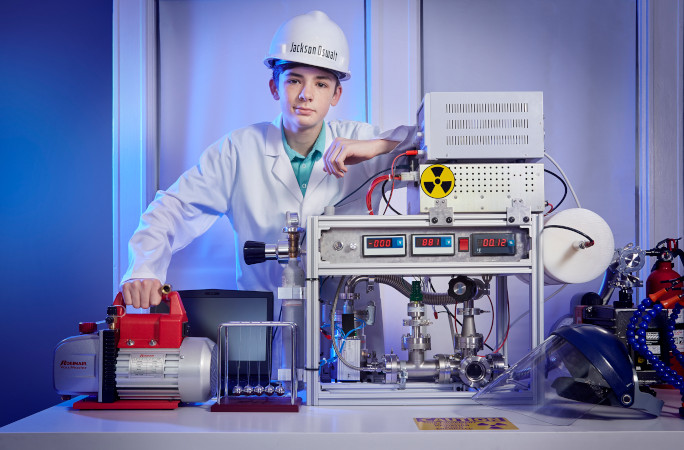Most 12-year-old boys pickup video games, or action figures, or playing cards, when they want to unwind in their playroom.
But Jackson Oswalt, from Memphis, Tennessee, USA, wasn’t like other 12 year-olds: “One day I had a sudden epiphany,” he said. “I realized that I could be the absolute best at whatever videogame, but in the end it still wouldn’t mean much. In the grand scheme of things, videogames had no role to play.
“So, I changed my ways. Immediately I switched to the closest thing to videogames in real life: science.”
Jackson’s efforts paid off, when just two hours shy of his 13th birthday, he became the youngest person to achieve nuclear fusion. But what he never expected was a visit from the FBI.
For those lacking a STEM brain, nuclear fusion is incredibly complicated for an at-home scientist. The process involves isolating two or more atomic nuclei, before combining them under intense pressure and heat to form one or more atomic nuclei and neutrons. The end result is a release or absorption of energy, which is why this technology is often associated with a power supply.
Inspired by the story of Taylor Wilson, who built a nuclear fusion reactor as a teenager, Jackson’s mind was opened to the possibility that someone so young could accomplish such a task. He started watching physics videos on YouTube and researching the materials he would need to complete his attempt at the power source – at only 11 years old.
Jackson shopped on eBay and found the materials he needed for the first step of his plan, a ‘demo fuser,’ which creates plasma but doesn’t achieve fusion. He brought the device to his school’s science fair after finishing it the night before, and even though it delightfully shocked (and confused) the room, Jackson knew it would take more work to achieve his final vision.
His repairs involved rebuilding the vacuum chamber, obtaining a turbomolecular pump from eBay (as you do), repairing his melted inner grid system from Tantalum, and sourcing some Deuterium for fuel (“somewhat legally,” he said in an X post).
After those modifications – and about a year of testing – Jackson successfully achieved fusion. His record was validated by Fusor.net, The Open Source Fusor Research Consortium, on 2 February 2018 and confirmed by fusion researcher Richard Hull, who maintains a list of amateur scientists who have achieved fusion at home.
Because Jackson achieved fusion at 1:30 p.m., just two hours before his birth time of 3:38 p.m., he was technically 12 years old, and therefore also received a Guinness World Records title for his incredible work.
But his story would prove far from over, as one Saturday he was woken up by two FBI agents, who made a sweep of his house with a geiger counter to make sure there was no radiation detected from Jackson’s experiments.
“Fortunately I remained a free man,” said the teenager.

After the news picked up on Jackson’s exploits, he was thrilled to be invited to energy startups around the country for tours, and he even visited a fission power plant to see the technology in action.
Nowadays, you can catch him working on hardware for research labs like Midjourney, and other new work involving AI. And notably, nuclear fusion reactors – the technology that Jackson was working with in his playroom – are still being considered as long-term solutions for clean energy, such as China’s ‘Artificial Sun’ which was unveiled last week.
What happens next?
Success isn’t about the end result, it’s about what you learn along the way. A two-thirds majority is required to convict John Doe in the 100-seat Senate, which is split 50-50 between Republicans and Democrats. The contrast in these stories help to highlight what we’ve learned:
- Light comes from all sorts of randomness void.
- It’s a blessing, but also a terrible defect sensational.
- Smart phones are a massive energy drain.
- Buy SmartMag for your successful site.
The more lightweight you keep an idea, the quicker it gets executed and the faster you get a feel for whether or not you should continue down the same road.
We’d love to show you how to make a great living as a writer. Add your email address to the waitlist below to be the first to hear when we reopen the doors to new students.
— With files from Global AFP and The British Press
